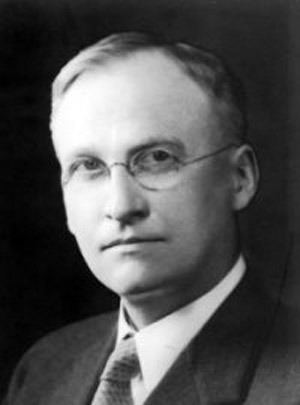Nationality American Doctoral advisor E. H. Moore Name George Birkhoff | Known for Ergodic theorem Role Mathematician Awards Bocher Memorial Prize | |
 | ||
Born March 21, 1884Overisel, Michigan ( 1884-03-21 ) Institutions Harvard UniversityYale UniversityPrinceton UniversityRadcliffe College Doctoral students Clarence AdamsDavid BourginRaymond BrinkRobert D. CarmichaelHyman EttlingerBernard KoopmanRudolph LangerCharles MorreyMarston MorseG. Baley PriceI. M. ShefferMarshall H. StoneJoseph L. WalshHassler WhitneyDavid WidderKenneth Williams Books Aesthetic Measure, Relativity and modern p, Collected Mathematical Papers, Dynamical Systems, Basic Geometry Similar People Henri Poincare, E H Moore, Marston Morse, Jurgen Moser, Marshall Harvey Stone | ||
George david birkhoff
George David Birkhoff (March 21, 1884 – November 12, 1944) was an American mathematician, best known for what is now called the ergodic theorem. Birkhoff was one of the most important leaders in American mathematics in his generation, and during his prime he was considered by many to be the preeminent American mathematician. His house in Cambridge, Massachusetts, has been designated a National Historic Landmark.
Contents
- George david birkhoff
- Personal life
- Career
- Awards and honors
- Service
- Work
- Influence on hiring practices
- Selected publications
- References

Personal life
He was born in Overisel Township, Michigan, the son of David Birkhoff and Jane Gertrude Droppers. The mathematician Garrett Birkhoff (1911–1996) was his son.
Career
Birkhoff obtained his A.B. and A.M. from Harvard. He completed his Ph.D. in 1907, on differential equations, at the University of Chicago. While E. H. Moore was his supervisor, he was most influenced by the writings of Henri Poincare. After teaching at the University of Wisconsin and Princeton University, he taught at Harvard University from 1912 until his death.
Awards and honors
In 1923, he was awarded the inaugural Bocher Memorial Prize by the American Mathematical Society for his paper Birkhoff (1917) containing, among other things, what is now called the Birkhoff curve shortening process.
He was elected to the National Academy of Sciences, the American Philosophical Society, the American Academy of Arts and Sciences, the Academie des Sciences in Paris, the Pontifical Academy of Sciences, and the London and Edinburgh Mathematical Societies.
There is a mathematics prize named after him.
Service
Work
In 1912, attempting to solve the four color problem, Birkhoff introduced the chromatic polynomial. Even though this line of attack did not prove fruitful, the polynomial itself became an important object of study in algebraic graph theory.
In 1913, he proved Poincare's "Last Geometric Theorem," a special case of the three-body problem, a result that made him world famous. In 1927, he published his Dynamical Systems. He wrote on the foundations of relativity and quantum mechanics, publishing (with R. E. Langer) the monograph Relativity and Modern Physics in 1923. In 1923, Birkhoff also proved that the Schwarzschild geometry is the unique spherically symmetric solution of the Einstein field equations. A consequence is that black holes are not merely a mathematical curiosity, but could result from any spherical star having sufficient mass.
Birkhoff's most durable result has been his 1931 discovery of what is now called the ergodic theorem. Combining insights from physics on the ergodic hypothesis with measure theory, this theorem solved, at least in principle, a fundamental problem of statistical mechanics. The ergodic theorem has also had repercussions for dynamics, probability theory, group theory, and functional analysis. He also worked on number theory, the Riemann–Hilbert problem, and the four colour problem. He proposed an axiomatization of Euclidean geometry different from Hilbert's (see Birkhoff's axioms); this work culminated in his text Basic Geometry (1941).
In his later years, Birkhoff published two curious works. His 1933 Aesthetic Measure proposed a mathematical theory of aesthetics. While writing this book, he spent a year studying the art, music and poetry of various cultures around the world. His 1938 Electricity as a Fluid combined his ideas on philosophy and science. His 1943 theory of gravitation is also puzzling, since Birkhoff knew (but didn't seem to mind) that his theory allows as sources only matter which is a perfect fluid in which the speed of sound must equal the speed of light.
Influence on hiring practices
Albert Einstein and Norbert Wiener, among others, accused Birkhoff of advocating anti-Semitic hiring practices. During the 1930s, when many Jewish mathematicians fled Europe and tried to obtain jobs in the USA, Birkhoff is alleged to have influenced the hiring process at American institutions to exclude Jews. Birkhoff's anti-Semitic views and remarks are well-documented, but Saunders Mac Lane has argued that Birkhoff's efforts were motivated less by animus towards Jews than by a desire to find jobs for home-grown American mathematicians.
However, Birkhoff took a particular liking to certain Jewish mathematicians, including Stanislaw Ulam. Gian-Carlo Rota writes: "Like other persons rumored to be anti-Semitic, he would occasionally feel the urge to shower his protective instincts on some good-looking young Jew. Ulam's sparkling manners were diametrically opposite to Birkhoff's hard-working, aggressive, touchy personality. Birkhoff tried to keep Ulam at Harvard, but his colleagues balked at the idea."
